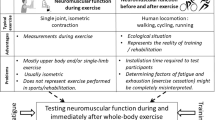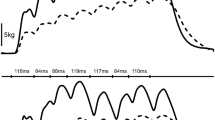Abstract
Purpose
The assessment of voluntary activation of the knee extensors using transcranial magnetic stimulation (VATMS) is routinely performed to assess the supraspinal function. Yet methodological scrutiny of the technique is scarce. The aim of the present study was to examine face validity and reliability of VATMS and its two main determinants (superimposed twitch during a maximal voluntary contraction [SIT100%] and estimated resting twitch [ERT]).
Methods
SIT100%, ERT, and VATMS were measured on ten healthy males (age 24 ± 5 years) before and following intermittent isometric fatiguing exercise on two separate occasions.
Results
The findings indicated issues regarding the accuracy of ERT and suggested a three-point relationship should not be used to determine ERT. Reliabilities for VATMS, SIT100%, and ERT were acceptable pre- but much weaker post-exercise (especially for SIT100%). Despite statistically significant changes in main neuromuscular variables following the intermittent isometric fatiguing exercise (P < 0.05), when post-exercise reliability was considered, the exercise effect on VATMS was smaller than the smallest detectable change in 18 of the 20 individual tests performed, and for the whole sample for one of two visits. Finally, maximal voluntary contraction was reduced significantly following the neuromuscular assessment (NMA) pre-exercise but recovered during the NMA post-exercise.
Conclusion
This is the first study to demonstrate a lack of sensitivity of key neuromuscular measurements to exercise and to evidence both presence of neuromuscular fatigue following the NMA in itself, and recovery of the neuromuscular function during the NMA post-exercise. These results challenge the face validity of this routinely used protocol.





Similar content being viewed by others
Abbreviations
- ERT:
-
Estimated resting twitch
- ICC:
-
Intraclass correlation
- KE:
-
Knee extensors
- MEP:
-
Motor evoked potential
- MVC:
-
Maximal voluntary contractions
- NMA:
-
Neuromuscular assessment
- POT:
-
Potentiated twitch force
- SDC:
-
Smallest detectable change
- SIT:
-
Superimposed twitch
- SIT100% :
-
Superimposed twitch during a maximal voluntary contraction
- TMS:
-
Transcranial magnetic stimulation
- VA:
-
Voluntary activation
- VATMS :
-
Voluntary activation using transcranial magnetic stimulation
- VC:
-
Voluntary contraction
References
Atkinson G, Nevill AM (1998) Statistical methods for assessing measurement error (reliability) in variables relevant to sports medicine. Sports Med 26:217–238. https://doi.org/10.2165/00007256-199826040-00002
Bachasson D, Temesi J, Gruet M, Yokoyama K, Rupp T, Millet GY, Verges S (2016) Transcranial magnetic stimulation intensity affects exercise-induced changes in corticomotoneuronal excitability and inhibition and voluntary activation. Neuroscience 314:125–133. https://doi.org/10.1016/j.neuroscience.2015.11.056
Beaulieu LD, Flamand VH, Masse-Alarie H, Schneider C (2017) Reliability and minimal detectable change of transcranial magnetic stimulation outcomes in healthy adults: a systematic review. Brain Stimul 10:196–213. https://doi.org/10.1016/j.brs.2016.12.008
Brownstein CG, Dent JP, Parker P, Hicks KM, Howatson G, Goodall S, Thomas K (2017) Etiology and recovery of neuromuscular fatigue following competitive soccer match-play. Front Physiol 8:831. https://doi.org/10.3389/Fphys.2017.00831
Carroll TJ, Taylor JL, Gandevia SC (2017) Recovery of central and peripheral neuromuscular fatigue after exercise. J Appl Physiol 122:1068–1076. https://doi.org/10.1152/japplphysiol.00775.2016
Clark BC, Cook SB, Ploutz-Snyder LL (2007) Reliability of techniques to assess human neuromuscular function in vivo. J Electromyogr Kines 17:90–101. https://doi.org/10.1016/j.jelekin.2005.11.008
Contessa P, Puleo A, De Luca CJ (2016) Is the notion of central fatigue based on a solid foundation? J Neurophysiol 115:967–977. https://doi.org/10.1152/jn.00889.2015
Di Lazzaro V et al (1998) Effects of voluntary contraction on descending volleys evoked by transcranial stimulation in conscious humans. J Physiol 508(Pt 2):625–633
Froyd C, Millet GY, Noakes TD (2013) The development of peripheral fatigue and short-term recovery during self-paced high-intensity exercise. J Physiol 591:1339–1346. https://doi.org/10.1113/jphysiol.2012.245316
Gandevia SC (2001) Spinal and supraspinal factors in human muscle fatigue. Physiol Rev 81:1725–1789
Gandevia SC, Allen GM, Butler JE, Taylor JL (1996) Supraspinal factors in human muscle fatigue: Evidence for suboptimal output from the motor cortex. J Physiol 490:529–536. https://doi.org/10.1113/jphysiol.1996.sp021164
Girard O, Racinais S (2014) Combining heat stress and moderate hypoxia reduces cycling time to exhaustion without modifying neuromuscular fatigue characteristics. Eur J Appl Physiol 114:1521–1532. https://doi.org/10.1007/s00421-014-2883-0
Girard O, Bishop DJ, Racinais S (2013) Hot conditions improve power output during repeated cycling sprints without modifying neuromuscular fatigue characteristics. Eur J Appl Physiol 113:359–369. https://doi.org/10.1007/s00421-012-2444-3
Goodall S, Romer LM, Ross EZ (2009) Voluntary activation of human knee extensors measured using transcranial magnetic stimulation. Exp Physiol 94:995–1004. https://doi.org/10.1113/expphysiol.2009.047902
Goodall S, Ross EZ, Romer LM (2010) Effect of graded hypoxia on supraspinal contributions to fatigue with unilateral knee-extensor contractions. J Appl Physiol 109:1842–1851. https://doi.org/10.1152/japplphysiol.00458.2010
Goodall S et al (2017) The assessment of neuromuscular fatigue during 120 min of simulated soccer exercise. Eur J Appl Physiol 117:687–697. https://doi.org/10.1007/s00421-017-3561-9
Green S, Robinson E, Wallis E (2014) Assessment of calf muscle fatigue during submaximal exercise using transcranial magnetic stimulation versus transcutaneous motor nerve stimulation. Eur J Appl Physiol 114:113–121. https://doi.org/10.1007/s00421-013-2757-x
Gruet M, Temesi J, Rupp T, Levy P, Verges S, Millet GY (2014) Dynamics of corticospinal changes during and after high-intensity quadriceps exercise. Exp Physiol 99:1053–1064. https://doi.org/10.1113/expphysiol.2014.078840
Hermens HJ, Freriks B, Disselhorst-Klug C, Rau G (2000) Development of recommendations for SEMG sensors and sensor placement procedures. J Electromyogr Kines 10:361–374. https://doi.org/10.1016/S1050-6411(00)00027-4
Hopkins WG (2000) Measures of reliability in sports medicine and science. Sports Med 30:1–15. https://doi.org/10.2165/00007256-200030010-00001
Hunter SK, Butler JE, Todd G, Gandevia SC, Taylor JL (2006) Supraspinal fatigue does not explain the sex difference in muscle fatigue of maximal contractions. J Appl Physiol 101:1036–1044. https://doi.org/10.1152/japplphysiol.00103.2006
Johnson MA, Sharpe GR, Williams NC, Hannah R (2015) Locomotor muscle fatigue is not critically regulated after prior upper body exercise. J Appl Physiol 119:840–850. https://doi.org/10.1152/japplphysiol.00072.2015
Jubeau M et al (2014) Changes in voluntary activation assessed by transcranial magnetic stimulation during prolonged cycling exercise. Plos One 9:e89157. https://doi.org/10.1371/journal.pone.0089157
Kufel TJ, Pineda LA, Mador MJ (2002) Comparison of potentiated and unpotentiated twitches as an index of muscle fatigue. Muscle Nerve 25:438–444. https://doi.org/10.1002/mus.10047
Lagan J, Lang P, Strutton PH (2008) Measurement of voluntary activation of the back muscles using transcranial magnetic stimulation. Clin Neurophysiol 119:2839–2845. https://doi.org/10.1016/j.clinph.2008.09.013
Lee M, Gandevia SC, Carroll TJ (2008) Cortical voluntary activation can be reliably measured in human wrist extensors using transcranial magnetic stimulation. Clin Neurophysiol 119:1130–1138. https://doi.org/10.1016/j.clinph.2007.12.018
Maffiuletti NA, Bizzini M, Desbrosses K, Babault N, Munzinger U (2007) Reliability of knee extension and flexion measurements using the Con-Trex isokinetic dynamometer. Clin Physiol Funct I 27:346–353. https://doi.org/10.1111/j.1475-097X.2007.00758.x
McGraw KO, Wong SP (1996) Forming inferences about some intraclass correlation coefficients. Psychol Methods 1:30–46. https://doi.org/10.1037/1082-989x.1.1.30
Merton PA (1954) Voluntary strength and fatigue. J Physiol 123:553–564
Mira J, Lapole T, Souron R, Messonnier L, Millet GY, Rupp T (2017) Cortical voluntary activation testing methodology impacts central fatigue. Eur J Appl Physiol 117:1845–1857. https://doi.org/10.1007/s00421-017-3678-x
Mokkink LB et al (2010) The COSMIN checklist for assessing the methodological quality of studies on measurement properties of health status measurement instruments: an international Delphi study. Qual Life Res 19:539–549. https://doi.org/10.1007/s11136-010-9606-8
O’Leary TJ, Morris MG, Collett J, Howells K (2016) Central and peripheral fatigue following non-exhaustive and exhaustive exercise of disparate metabolic demands. Scand J Med Sci Spor 26:1287–1300. https://doi.org/10.1111/sms.12582
Peacock B, Westers T, Walsh S, Nicholson K (1981) Feedback and maximum voluntary contraction. Ergonomics 24:223–228. https://doi.org/10.1080/00140138108559236
Periard JD, Christian RJ, Knez WL, Racinais S (2014) Voluntary muscle and motor cortical activation during progressive exercise and passively induced hyperthermia. Exp Physiol 99:136–148. https://doi.org/10.1113/expphysiol.2013.074583
Rossi S, Hallett M, Rossini PM, Pascual-Leone A (2011) Screening questionnaire before TMS: an update. Clin Neurophysiol 122:1686–1686. https://doi.org/10.1016/j.clinph.2010.12.037
Schambra HM et al (2015) The reliability of repeated TMS measures in older adults and in patients with subacute and chronic stroke. Front Cell Neurosci 9:335. https://doi.org/10.3389/Fncel.2015.00335
Sidhu SK, Bentley DJ, Carroll TJ (2009a) Cortical voluntary activation of the human knee extensors can be reliably estimated using transcranial magnetic stimulation. Muscle Nerve 39:186–196. https://doi.org/10.1002/mus.21064
Sidhu SK, Bentley DJ, Carroll TJ (2009b) Locomotor exercise induces long-lasting impairments in the capacity of the human motor cortex to voluntarily activate knee extensor muscles. J Appl Physiol 106:556–565. https://doi.org/10.1152/japplphysiol.90911.2008
Sogaard K, Gandevia SC, Todd G, Petersen NT, Taylor JL (2006) The effect of sustained low-intensity contractions on supraspinal fatigue in human elbow flexor muscles. J Physiol 573:511–523. https://doi.org/10.1113/jphysiol.2005.103598
Tamm AS, Lagerquist O, Ley AL, Collins DF (2009) Chronotype influences diurnal variations in the excitability of the human motor cortex and the ability to generate torque during a maximum voluntary contraction. J Biol Rhythm 24:211–224. https://doi.org/10.1177/0748730409334135
Taylor JL, Todd G, Gandevia SC (2006) Evidence for a supraspinal contribution to human muscle fatigue. Clin Exp Pharmacol P 33:400–405. https://doi.org/10.1111/j.1440-1681.2006.04363.x
Terwee CB, Mokkink LB, van Poppel MNM, Chinapaw MJM, van Mechelen W, de Vet HCW (2010) Qualitative attributes and measurement properties of physical activity questionnaires A checklist. Sports Med 40:525–537. https://doi.org/10.2165/11531370-000000000-00000
Thomas K, Goodall S, Stone M, Howatson G, Gibson AS, Ansley L (2015) Central and peripheral fatigue in male cyclists after 4-, 20-, and 40-km time trials. Med Sci Sport Exerc 47:537–546. https://doi.org/10.1249/Mss.0000000000000448
Thomas K, Elmeua M, Howatson G, Goodall S (2016) Intensity-dependent contribution of neuromuscular fatigue after constant-load cycling. Med Sci Sport Exer 48:1751–1760. https://doi.org/10.1249/Mss.0000000000000950
Todd G, Taylor JL, Gandevia SC (2003) Measurement of voluntary activation of fresh and fatigued human muscles using transcranial magnetic stimulation. J Physiol 551:661–671. https://doi.org/10.1113/jphysiol.2003.044099
Todd G, Taylor JL, Gandevia SC (2004) Reproducible measurement of voluntary activation of human elbow flexors with motor cortical stimulation. J Appl Physiol 97:236–242. https://doi.org/10.1152/japplphysiol.01336.2003
Todd G, Taylor JL, Butler JE, Martin PG, Gorman RB, Gandevia SC (2007) Use of motor cortex stimulation to measure simultaneously the changes in dynamic muscle properties and voluntary activation in human muscles. J Appl Physiol 102:1756–1766. https://doi.org/10.1152/japplphysiol.00962.2006
Todd G, Taylor JL, Gandevia SC (2016) Measurement of voluntary activation based on transcranial magnetic stimulation over the motor cortex. J Appl Physiol 121:678–686. https://doi.org/10.1152/japplphysiol.00293.2016
Tok S, Binboğa E, Guven S, Çatıkkas F, Dane S (2013) Trait emotional intelligence, the Big Five personality traits and isometric maximal voluntary contraction level under stress in athletes. Neurol Psychiatry Brain Res 19:133–138. https://doi.org/10.1016/j.npbr.2013.04.005
Ugawa Y, Terao Y, Hanajima R, Sakai K, Kanazawa I (1995) Facilitatory effect of tonic voluntary contraction on responses to motor cortex stimulation. Electromyogr Motor C 97:451–454. https://doi.org/10.1016/0924-980x(95)00214-6
Vigotsky AD, Halperin I, Lehman GJ, Trajano GS, Vieira TM (2017) Interpreting signal amplitudes in surface electromyography studies in sport and rehabilitation sciences. Front Physiol 8:985. https://doi.org/10.3389/fphys.2017.00985
Acknowledgements
The authors thank Dr. Rosie Twomey and Prof. Guillaume Millet for the valuable critical review of our manuscript.
Funding
No external funding was received for this work.
Author information
Authors and Affiliations
Contributions
All authors contributed to the conception and design of the study. PA, AGT, JW, LS collected the data. All authors were involved in the analysis and interpretation of the data. JD, AGT and PA wrote the manuscript. All authors reviewed and approved the final version of the manuscript.
Corresponding author
Ethics declarations
Conflict of interest
The authors report no conflict of interest for this work.
Additional information
Communicated by Nicolas Place.
Publisher’s Note
Springer Nature remains neutral with regard to jurisdictional claims in published maps and institutional affiliations.
Rights and permissions
About this article
Cite this article
Dekerle, J., Ansdell, P., Schäfer, L. et al. Methodological issues with the assessment of voluntary activation using transcranial magnetic stimulation in the knee extensors. Eur J Appl Physiol 119, 991–1005 (2019). https://doi.org/10.1007/s00421-019-04089-7
Received:
Accepted:
Published:
Issue Date:
DOI: https://doi.org/10.1007/s00421-019-04089-7




